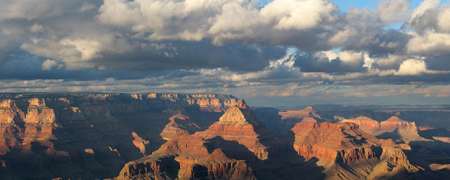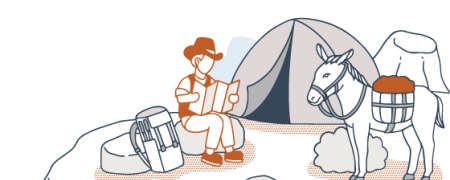Popular Grand Canyon Animals
California Condor
In the 1980’s there were only 22 California condors left in the wild and the species was on the brink of extinction. All of the remaining birds were captured and placed in captive breeding facilities which worked surprisingly well and by the 1990’s the population was stable enough to begin releasing the birds to the wild again. In 1996, six young captive bred condors were released at Vermillion Cliffs (30 miles north of Grand Canyon) and they have been soaring over the park ever since. Today, the condor population is nearing 500 birds, and there are roughly 75 condors that call Grand Canyon and the Colorado Plateau home.
Condors are scavengers and only eat dead animals, which is why you see them soaring around all day; a condor never stops looking for its’ next meal. Condors are the largest flying birds in North America with a wing span of 9.5 feet. The bottom of their wings have a distinct black and white pattern that is easy to recognize, with a triangular patch of white extending from their armpit to wingtip, and black on the rest of their wings. Condors don’t flap their wings but instead gracefully soar on the warm air that rises up from the bottom of Grand Canyon, making afternoon the best time to look for them. The best places to look for condors is usually Lookout Studio or Hopi Point on the South Rim, Plateau Point off of the Bright Angel Trail in the inner canyon, or perching on the Navajo Bridge on Highway 89A on the East Rim. Pairs of condors have been nesting at the canyon every year and sometimes their nests are visible to the public; inquire at a park Visitor Center for information about current condor nests or sightings.
Rocky Mountain Elk
Elk at Grand Canyon are hard to miss—males can weigh up to 700 lbs and their fall rutting displays are impressively loud and flamboyant. Today you will see herds of Rocky Mountain elk along the South Rim of the canyon, despite being a long way from the Rocky Mountains. After Merriman’s elk were hunted to extinction in the Southwest, hunters were looking for a way to bring these majestic animals back to the area so they jumped on the offer from Yellowstone National Park to ship a few trainloads of “excess” elk to Williams, AZ. Eventually the animals made their way to Grand Canton and are today one of visitors favorite animals to spot.
Because elk are not adapted to desert living, they rely heavily on human water sources to survive at Grand Canyon. It is not unusual to see elk drinking from the park’s water bottle filling stations, with one holding the spout down with their nose while another drinks! Even though these elk are often spotted in human areas, do not approach them—both rutting makes and females with babies are extremely aggressive and could cause you serious harm if you get too close for photos. Look in the ponderosa pine and pinyon-juniper forests along the South Rim roads to spot elk as you travel on the shuttle buses or trails.
Mule Deer
The much smaller cousin of the elk, mule deer are another visitor favorite to spot at Grand Canyon, both on the South and North Rims. These small, hoofed animals have large, swiveling ears that they use to listen for approaching danger. Because of the small size of their young, mule deer are on many predator’s menus so they have to stay alert for approaching coyotes, bobcats or mountain lions.
After the Grand Canyon National Game Preserve was established on the North Rim by Teddy Roosevelt in 1906, all area predators were heavily hunted which made the deer population explode. The deer were sick and starving due to lack of food so, in 1924, George McCormick tried to solve the problem by hiring hands and attempting to “drive” the excess deer across the Grand Canyon, via a crossing of the Colorado River. Not surprisingly, the drive didn’t work but eventually the herds on both rims of the canyon became healthy again after predator populations began to increase. Today, you can see deer at Grand Canyon year-round and they are most active at dawn and dusk
Bighorn Sheep
Bighorn sheep are some of Grand Canyon’s most impressive athletes; they can easily balance and carry up to 30lbs of weight on top of their heads in their massive, curling horns as they gracefully jump, run and climb on nearly vertical cliffs and knife-thin ledges looking for food and water. Bighorn sheep are well-adapted to harsh desert environments and avoid predators by walking out onto rocky areas that other animals wouldn’t dare climb out on. Like most areas of the West, the Grand Canyon bighorn sheep population is also declining due to lack of food and water as drought and warm temperatures threaten their habitat.
Bighorn sheep can can be spotted almost anywhere in the canyon, from rim to river. Visitors will spot them on the South Rim in Grand Canyon Village and while hiking on the Bright Angel or a South Kaibab trails. For some reason, fall seems to be the best time of year to spot them along the rim. Bighorn sheep are also a special part of many Grand Canyon river trips—you feel like a visitor in their quiet world as you paddle by a herd peacefully drinking from the Colorado River.
Kaibab and Abert’s Squirrels
Also called tasseled-eared squirrels, these two adorable squirrel species are closely related but live on opposite sides of the canyon. While the tall tale of the canyon is that the squirrels must have been separated on opposite rims as the Colorado river carved the canyon between them, the squirrels were actually separated much more recently by receding ponderosa pine forests after the end of the last ice age.
Today you find the grey and white Abert’s squrirels on the South Rim (and throughout other Western ponderosa pine forests) but the Kaibab Squirrel is endemic to the Kaibab Plateau so you must visit Grand Canyon’s North Rim if you’d like to see one. The Kaibab squirrel has a dark brown (almost black) body that scientists think helps them absorb heat from the sun to keep them warm on cool North Rim days and nights. Their bright white tails come in handy when hawks and goshawks are hunting them overhead—they cover their dark colored bodies with their tails to blend in perfectly with the snow!





